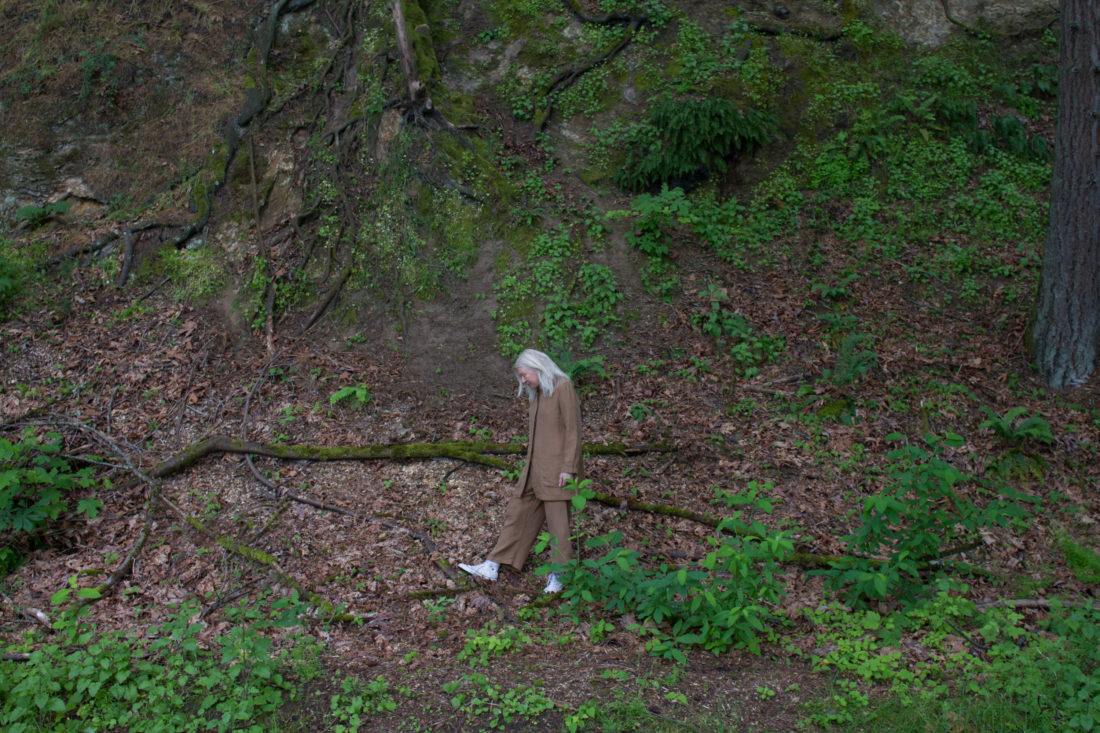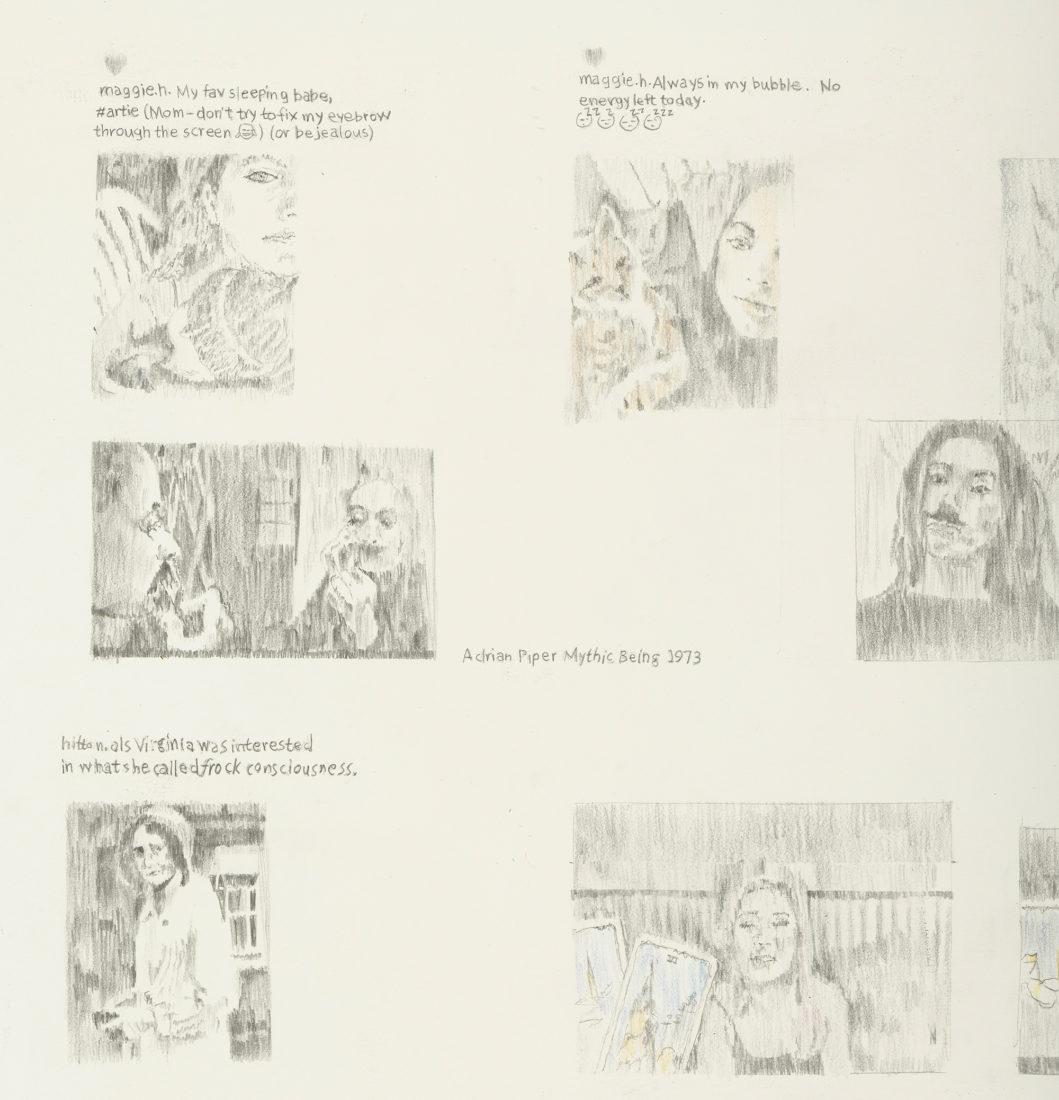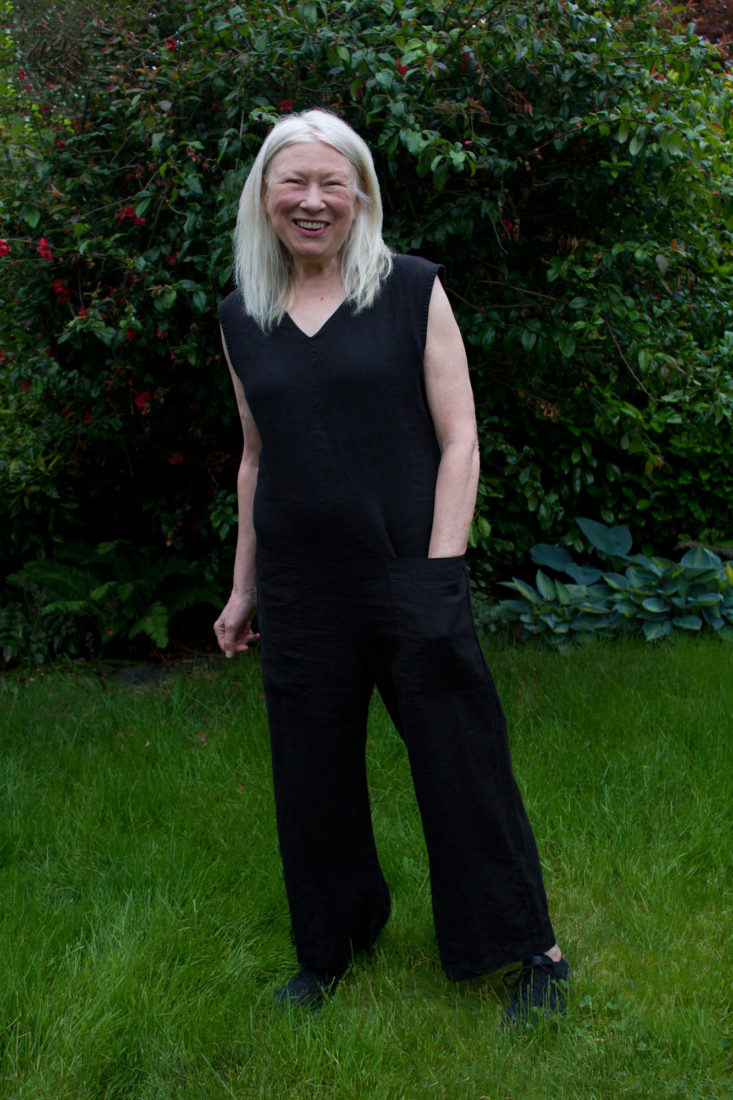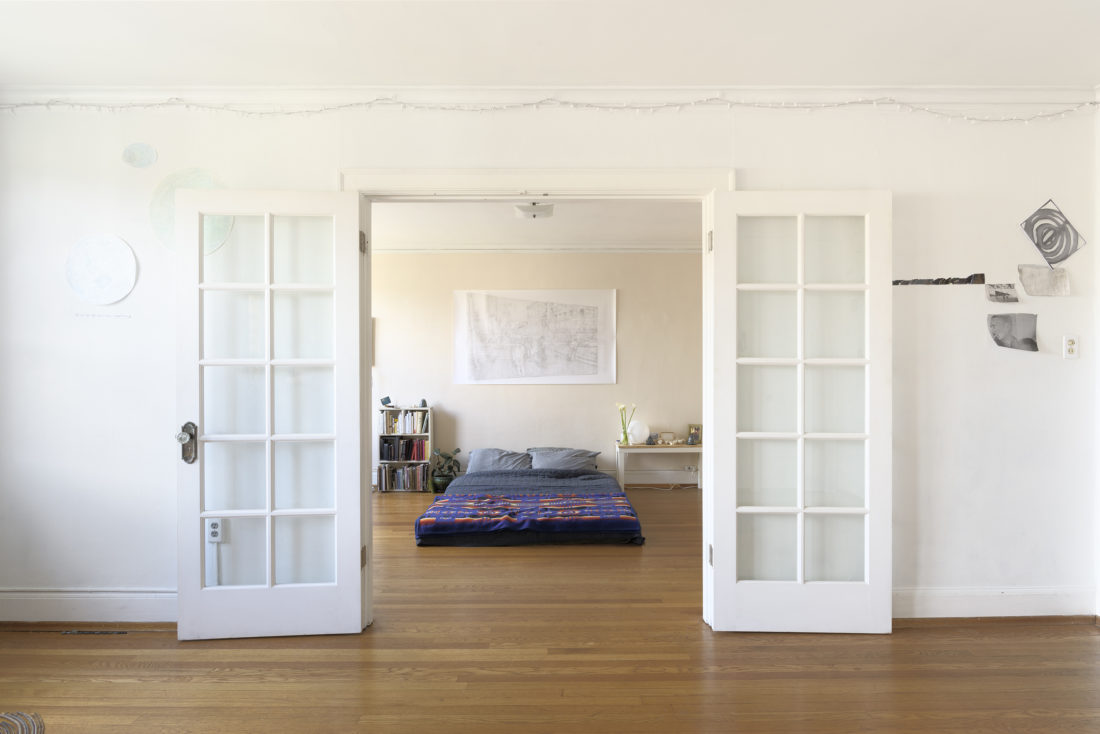
Can you tell us a bit about your origin?
Swedish, German, English, Starseed.
What are the ideas or values embedded in the garments you select for your wardrobe?
A kind of sleeve-like garment I can wear, that feels like an extension of myself. Solid and simple. I think about Andrea Zittel making such a “uniform” for herself, and I imagine she did this, so she felt held, could depend on this uniform. I also resonate with what I’ve read Hilton Als say about Virginia Woolf having “frock consciousness.” I take this to mean that a person can give their body a giving and neutral space to move in.

What is it like to be an artist in the world?
To observe and interpret, while developing a skill set. To take that skill set and use its equity to observe and interpret in still other media, keep moving and following inclinations. One inclination leads to another, it becomes like a corridor of doors. To be an artist is to represent—myself and others—to put out some kind of energetic field for being.
Who are those who have influenced you and how?
Vija Celmins, for her works originating in photography, for one. French filmmaker Agnès Varda (about her film Les plages de’ Agnès): Varda says: “But gleaning is getting things that are abandoned. I did not abandon my early pictures, my photos, my early films. It’s just going through my body of work as something I can pick from—I pick this and that and that. It’s like I had a collection of my work and I could choose this one or this one. ” One way I relate to this, is that my work is inspired by an ongoing personal artifact collection, the process of creating is iterative.


You’re both a visual artist and a writer, tell us about that intersection in your life and your relationship to these mediums.
My drawings have always been textual, in that they’re trying to get at or depict something transitory, but important, nonetheless, while transmuting something else. In my drawings, I’m trying to make something be still for a moment, with the understanding that it’s really in movement. With my writing, I commit something to a page to give a feeling, it can’t stand for all time, but there it is, committed as the version to be going with right now. This parallel shows up in my remarks here, as I’ve kept specific texts at-hand that have affected and influenced my work from early on: Vija Celmins: Material Fictions, by Nancy Princenthal in Parkett No. 44; Sheila Heti in Believer Magazine

You recently had an exhibition at The Frye Art Museum “Air, the free or unconfined space about the surface of the earth” which explores your perception of personal and historical memory – some of which included drawings from Instagram posts by people you follow, as well as a list of words that cycle through your head in repetition. Can you tell us about these references and your relationship to these repetitions.
I appreciate what Amanda Donan and Erin Langner wrote about Narrative Drawing (made from drawings from Instagram posts), that embodies what you describe: “Narrative Drawing is a collection of small notational drawings based on images, songs, videos, and commentaries Bennett encountered online in YouTube videos and on her Instagram feed over the course of completing the drawing. Described by Bennett as “a dictionary of an adventurous visual and textual language,” these truncated references map the various literary, cultural, and artistic sources that have lately informed her dual practices as a visual artist and writer.”
By making small drawings that accumulate every few days into one large-scale drawing, I established a structure and routine for making work, but left room for flexibility, to account for the shifts in my awareness, and to demarcate the transformation / transmutation, of my creative circumstances. The beginning of this large-format pencil drawing series was to make the small drawing of my niece, from Instagram. This was the first entry to Narrative Drawing, my foot-hold for beginning, since I felt different day to day, moment to moment. At first, this caused a problem for me, for making the work. But by making one small drawing at a time, I could show what was resonating with me in the moment, filtered through what I looked at each day, including Teju Cole’s text and image posts, details of western painting, that abstract beyond their circumstances, leave room for movement.



This attention to repetition and patterns reminds me of your car series, surrounding your Buick. Can you tell us about that series?
I made a drawing series of a pretty nondescript car I had at the time, based on photos of cars in my neighborhood that look like mine. I wanted to create a space of softness, where the viewer could place and see themselves. Seeing my Buick everywhere was a way to see me outside of myself and to dissolve into something bigger, through the filter of this tan car, that my dad gave me.

When you taught at Cornish many years ago you introduced me to filmmaker Agnés Varda, who quickly became one of my greatest influences. She passed away earlier this year and I would love to hear your thoughts on her creations and influence on you.
The first film I saw of Agnés Varda’s was The Gleaners and I. It stopped me. I’ve seen this film multiple times. It follows gleaners, as they forage for food, and it points to itself as being collected or compiled in that same way, a film of images gathered and compiled by a woman. An online essay on “Gleaners” by Homay King states that digital media disembodies and frees the referent from its frame, while “Gleaners” rematerializes the digital, by hooking it back into time and passing seasons. I like this idea of time, that we play with it as we play it out. That we admire its potential for accretion.
Here’s a list I made the first time I ever saw The Gleaners and I, I transposed it once for you:
Gleanings for Sierra
Transcribed from Post-it notes made from Agnès Varda’s The Gleaners and I:
—
She accommodates chance
The aim of art is to tidy up
Creating an odd dictionary
An encounter
Bend down, bring up, to glean
Pull down, bring to me, to pick
Understanding stickers is a language
Pin down, write down
What is picked up already had a life, it is still alive
Written phrases, I secure what I notice by writing down
This costs me nothing
I got it in my fist, with my hand. as my eye watched
Picking up after, I clear
What if the tagger revisits its discharge, tracing, as I do, the same steps every few days, to find it gone?
But.
She left it, didn’t she? Abandoned. It can’t be stolen if it has no owner, left.
You don’t let things go by. Gleaning is always on private property. But it is made public and that happens.
I am glad to know they are there, as I am glad to know where the hole in the road is.
They are less than. I cannot describe it.
They will yell, miss everything, react badly.
You glean things that sprout, come up, you pick things that hang, pull down.
A painting titled “Gleaners Before the Storm”
Written phrases
I secure things by writing them down, down
Already had a life, still alive, waiting
Language, understanding stickers, they have told.
Bend down, pick up.
Pull down, I bring this up.
An encounter
Creating an odd dictionary
Ruth
People pick each other up.
If I drove, rather than walked, I’d have to pick up different things, gather differently, the heft.
Things from the world.
Two chairs from the street.
I was walking
Eve was in a truck, before I met her,
I found them first but was out of film.
I couldn’t take them, but I
Found the two chairs again later in Eve’s house.
—

Thinking about identity and the visual representations we have access and authority over – how would you describe your aesthetic and how it informs you? Does getting dressed put you at ease or add stress? You have always had a clear sense of style to me and I wondered if that is something you grew into or always had? Or does it vary year to year, day to day, hour to hour?
It shifts. Prairie gives me a template, so I’m able to choose outfits each day that are pleasing, this eliminates stress. I can just be inside the sheathe provided, which gives me form, structure, spatial understanding, a way for me to have my body, to not wish it was different, but lets me bring all of that into the outline. I can continue to change, reveal myself, have lightness, in both weight and vision.

What do you see in the future – near and far?
I feel the realness of everything being part of one big thing, more and more. In the near future, I hope to be contributing–you could say culturally–through writing. I’m working on a collection of essays right now. I’d also like to do something alongside the writing, like energy work, something that taps into empathy. To contribute to the feeling that everyone’s right where they need to be, in some divine spot only they could dream up for themselves. It’s still going to be about gathering and reconfiguring–whether its energy, or ephemera. And about very simple envelopes or templates for creating in that way.


